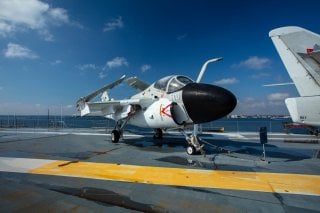The A-6 Intruder Bomber Fought Hard for the Navy and Marines in Vietnam
The A-6 wasn’t built to break speed or altitude records, or even to be superlative in those respects. Rather, the A-6 was built to deliver weapons on-target in any weather condition.
The Grumman A-6 Intruder was the first all-weather attack aircraft ever to serve with the U.S. Navy and Marine Corps. First introduced in 1963, the A-6 stood out as a subsonic aircraft with rounded features at a time when aerospace development was fixated on supersonic, pointed craft like the Century Series and the X-15. But what the A-6 lacked in speed, or aesthetics, it made up for with the ability to carry an impressive nine tons worth of ordnance, rain or shine.
All-weather capable
Serving for thirty-six years, the A-6 was a hallmark of the Navy and Marine Corps’ offensive capabilities. The airframe resulted from a Bureau of Aeronautics request for an all-weather attack aircraft that could one, perform short-distance takeoffs and landings; two, perform long-range interdiction missions; and three, provide close air support. The A-6 was the answer. Expected to replace the ageing, prop-driven A-1 Skyraider, the A-6 actually coexisted with the A-1 in service until 1973, at which point the A-1 was finally retired from active service. The A-6 was indeed superior to the A-1 (whose airframe would serve as the foundation for the A-10 Warthog). Whereas the A-1 had been confined to fair-weather operations, the A-6 was capable of all-weather operations—thanks in large part to the inclusion of a turbine engine.
Built by Grumman, who would later build the Lunar Module within which the Apollo astronauts would descend to the lunar surface, the A-6 featured an unusual configuration inside the cockpit: the pilot and the bombardier/navigator sat side-by-side rather than stacked front to back. The pilot sat in the left seat while the bombardier/navigator sat in the right seat, positioned slightly to the back of the pilot to afford the pilot an unobstructed field of vision.
Further facilitating all-weather operations was the inclusion of a then-novel piece of technology, the Vertical Display Indicator (VDI), which offered pilots a synthetic projection of the landscape below; the VDI made navigating difficult terrain in low-visibility conditions significantly easier.
Essentially a bomber
The A-6 was essentially a small bomber. Incapable of breaking the sound barrier, the A-6 had a top speed of just 640 miles per hour—not much faster than a commercial airliner—a climb rate of just 7,620 feet per minute, and a service ceiling of 42,400 feet. By comparison, the F-4 Phantom, developed around the same time as the A-6, enjoyed a climb rate of 41,000 feet per minute and a service ceiling of about 60,000 feet.
But the A-6 wasn’t built to break speed or altitude records, or even to be superlative in those respects. Rather, the A-6 was built to deliver weapons on target in any weather condition. And with respect to delivering weapons on target, the A-6 was superlative. Outfitted with five hardpoints, the A-6 could carry nine tons of payload. The massive payload capacity gave the Navy and Marine Corps a reliable option during the Vietnam War.
Harrison Kass is a senior defense and national security writer with over 1,000 total pieces on issues involving global affairs. An attorney, pilot, guitarist, and minor pro hockey player, Harrison joined the US Air Force as a Pilot Trainee but was medically discharged. Harrison holds a BA from Lake Forest College, a JD from the University of Oregon, and an MA from New York University. Harrison listens to Dokken.
Image:

